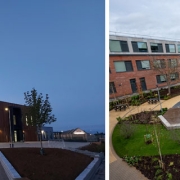The launch of the Department for Education’s rebuilding programme, combined with the Government’s ‘presumption in favour of offsite building’ is increasing demand for this method of construction. Here, Jim Cowell, Technical Director at Algeco considers some of the benefits it offers the education sector.
Following the UK Government’s announcement of a ‘presumption in favour of offsite,’ all building projects should have at least one option that includes the substantial use of offsite manufacture during the development stage. Combined with a school rebuilding and refurbishment push by the Department for Education, many schools are opting for modular design builds.
One key factor in the rising popularity of modular construction – both within an offsite and temporary building hire programme – is its cost-effectiveness. Long-term running costs of modular buildings are often lower than those of traditional brick and mortar buildings, due to the modules being produced in a quality assessed production facility with high manufacturing tolerances at critical interfaces. Often, achieving these on site can be more challenging due to skills shortages and inclement weather, for example.
Offsite construction offers a quicker, less disruptive alternative to traditional construction. Utilising DfMA (Design for Manufacturing Assembly) and Lean Manufacturing, combined with Seismic design innovation, allows us to deliver building modules with a high PMV (Pre Manufacturer Value) of around 80 percent. It’s why we approach all our projects using DfMA, including more recent school builds at Laurence Calvert Academy in Leeds and Northampton School.
Completed the majority of work in a controlled, factory environment lifts any limitations usually imposed by weather. It also reduces the level of disruption to the school itself, mitigating any distractions caused by noise and alleviating health and safety concerns associated with a traditional construction site. As the majority of the building is completed offsite, insertion of the modular building onto the school grounds can easily be co-ordinated with school holidays, avoiding any disruption to learning.
Compared to traditional construction, modular construction produces a limited amount of waste, as classrooms are designed to tight specifications, with any excess materials from design modifications being reused for later projects. As modular buildings are completed offsite, vehicular traffic from travel to and from the construction site is eliminated, meaning CO₂ levels are lower than that of a traditional construction site.

Permanent offsite builds: Hatchlands Primary School
Due to residential developments and increasing birth rates in the area, a new school was developed in Redhill, Surrey.
Adjacent to a Conservation Area, offsite construction of the school using our permanent modular building system meant that the modules were delivered with a PMV of 85%, and ready for final finishing on-site. This reduced the construction schedule by around 50%, compared to a traditional on-site build, with completion in just 32 weeks.
The new school was funded by the DfE and operated by the Everychild Trust – a multi-academy trust, whose aim is to “Engage, equip and empower every child”. Development of the school was part of a Modular-A Primary School component solution framework.
The 420-place school had to be created on a similar footprint to the existing structure and within the same two-storey height limit.
The designers were DLA Architects who worked with our offsite team to develop a component-centred solution based on the Algeco market leading modular system. Hatchlands was designed in a contemporary style using brick, cedar cladding, purple panelling to complement the school’s branding, render and significant glazed elements to create light filled teaching spaces.
Built to high sustainability standards, the school achieves a BREEAM Very Good Rating, placing it within the top 25% of buildings, in terms of sustainability, aligning with the goals of Reigate and Banstead Borough Council. Transmittance of noise was minimised, meeting minimum standards set out in The Building Bulletin 93 (BB 93) ‘Acoustic Design of Schools: A Design Guide,’ through the construction of a suspended concrete floor in the module.
A large span sports hall was created using our Hybrid system, providing the school with a valuable space that is now used for assemblies, sports and performances. The system allows incorporation of large open atriums and increased ceiling heights and can be fully integrated with the modules to provide greater design scope.
Temporary modular buildings for hire
Changes in pupil numbers and demographics are putting pressure on education providers nationwide. It’s one of the reasons why more education providers are opting for temporary classrooms, because it allows them to create extra places, quickly. They can also be used to move the whole school into interim facilities while new permanent offsite buildings are created.
Schools that choose the hire route avoid the need for CapEx and lengthy sign-off processes whilst having the flexibility to use the buildings for as long as they want. This aligns well with sustainable and circular economy principles because the buildings are refurbished and re-used when they are decanted from site. Hiring temporary classroom is a cost effective solution for schools looking to respond rapidly to changes in pupil numbers.
CLICK HERE to discover more about temporary classroom hire



